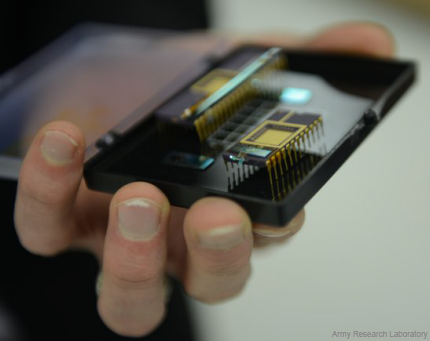Army's robotic insect research takes wing
An ARL micro-robotics team creates functional fly-like wings and millipede-like legs while working to develop the ultimate "fly on the wall."

A tiny micro-robotic insect wing hangs off the front of a circuit board.
The idea of being a “fly on the wall” in an enemy headquarters has been a goal of intelligence agencies for as long as there have been intelligence agencies. But other than being able to insert a double-agent or managing to plant listening devices, the options are limited. The Army Research Laboratory is working on another possibility: an actual fly, or rather a robotic one, which could mimic the insect’s movements while transmitting surveillance data.
Although researchers have been making progress in shrinking the size of autonomous systems, operating at the insect level won’t happen anytime soon. But Dr. Ron Polcawich and his ARL team have gained some ground in developing tiny actuators and wings capable of creating lift, according to an ARL release.
The wings, which are 3 to 5 centimeters in length, are made of lead zirconium titanate, which can create an electric charge under pressure and bend and flap when voltage is applied. "We demonstrated that we can actually create lift," Polcawich said in the release. "So we know this structure has the potential to fly."
The micro-fabrication team, working on what’s called piezoelectric microelectromechanical systems, or PiezoMEMS, also has created tiny legs that respond to voltage by crawling and could be used in a millipede-like robot.
But there’s still a long way to go—Polcawich estimates 10 to 15 years—before robotic insects are a reality. The smaller the robotic insect, the bigger the challenge. Among the challenges are developing the complex algorithms necessary to give a robotic insect the cognitive ability, or artificial intelligence, to realistically mimic an insect’s movements. One example Polcawich gave was in how a fly reacts to wind, tumbling first before stabilizing itself.
Another challenge is funding, which he said is in relatively short supply for micro-robotics. One way to get around that is to open up the research for collaboration with industry and academia, which ARL is doing with the Open Campus pilot program launched earlier this year. ARL recently drew 450 scientists to an open house at ARL’s Kirkland Center in Silver Spring, Md.
Open Campus, which will offer layered access to research projects—requiring security clearances for any classified projects—is expected to be a “game changer” for developing new technologies, Gabriel Camarillo, principal deputy to the assistant secretary of the Army for Acquisition, Logistics and Technology, said at the open house.
The pilot so far has worked with about 200 students and industry researchers, and "This is just the beginning,” ARL Director Thomas Russell said.
Polcawich, who has already collaborated with Harvard University’s Ron Wood, who is developing a larger “RoboFly,” agreed. "The Open Campus effort will hopefully streamline the creative process," he said.




